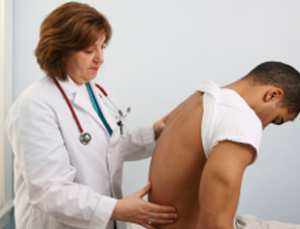Back Pain

About 80% of adults will suffer significant back pain at some time in their lives due to an injury at work, at home or at play. Back pain and medical spine problems can be caused by:
- Mechanical difficulties when you move your spine in a specific manner
- Injuries such as a sprain or fracture
- Conditions such as arthritis or scoliosis
- Infections or tumors
Doctors generally diagnose spine problems by:
- Physical examination
- Diagnostic tests (such as x-rays, bone scan, CAT scan, MRI, arthroscopy, and biopsy)
- Medical History
Conservative forms of treatment will generally be the first line of defense against most forms of back pain. This may include medication to reduce pain, such as aspirin and acetaminophen, or medication to reduce swelling and inflammation, such as ibuprofen and nonsteroidal anti-inflammatory drugs (NSAIDs). Physical therapy is often effective, with patients practicing exercises to improve flexibility and strength. In addition, lifestyle changes may be recommended, including those that will lead to the maintenance of a healthy body weight.
If the back pain is unresponsive to conservative treatments or has been brought on by a more serious condition, surgery may be recommended. Spine surgery involves several different procedures that target affected vertebrae within the spine. These procedures are effective in treating a wide range of spinal conditions, including diseases, degeneration, injuries and more. Some of the conditions treated with spine surgery include:
- Degenerative disc disease
- Spinal stenosis
- Fractures
- Herniated disc
- Lower back pain
- Infection
- Scoliosis
- Tumors
How is Spine Surgery Performed?

A few days after surgery, patients are encouraged to get up and walk around to regain strength. Changing positions often and maintaining good posture can help minimize pain and promote proper healing. Patients should follow their doctor’s individual instructions for when they can return to work and other regular activities.
Common Spine Procedures
Discectomy and Fusion – This procedure involves removing an intervertebral disc and/or bone spurs that are putting pressure on nerve roots. This condition is a result of a herniated or degenerated disc. This removed disc may be replaced with a small bone graft, which will allow the vertebrae to fuse together over time. The space may also be left open.
Laminectomy – This procedure relieves pressure caused by spinal stenosis and disc degeneration. During a laminectomy, a small section of bone that covers the back of the spinal cord, called the lamina, is removed. The removal of this bone and any bone spurs relieves pressure on the spinal cord. The remaining spine bones can be connected with titanium metal rods.
Spine Fusion Surgery – Spine fusion is a surgical procedure used to link together vertebrae, often because of a damaged disc. During the procedure, bone growth is stimulated and then used to link the vertebrae together to stop painful movement in the area.
Risks and Complications of Spine Surgery
It is important for patients to realize that spine procedures are major surgical procedures that carry certain risks with them. Fortunately, the benefits of these procedures usually far outweigh the risks, as patients are relieved of intense pain and other troubling symptoms.
Although rare, some of the risks of these procedures may include:
- Infection
- Bleeding
- Reactions to anesthesia
- Injury to the spinal cord
- Pain at the treated site
- Damage to nerves or arteries
- Blood clots
- Paralysis
These risks can be minimized by choosing an experienced surgeon to perform your procedure, and by adhering to your surgeon’s instructions before and after your procedure.

